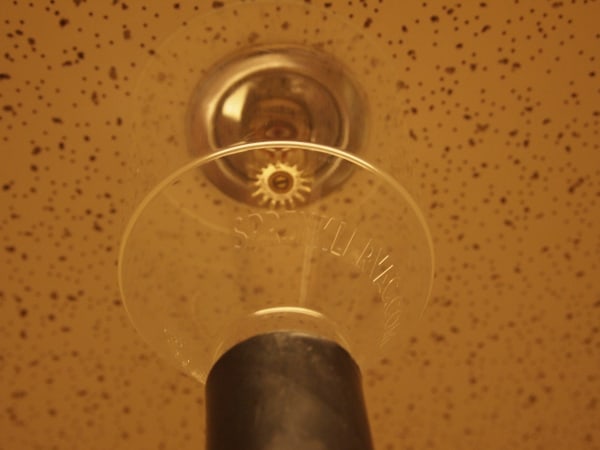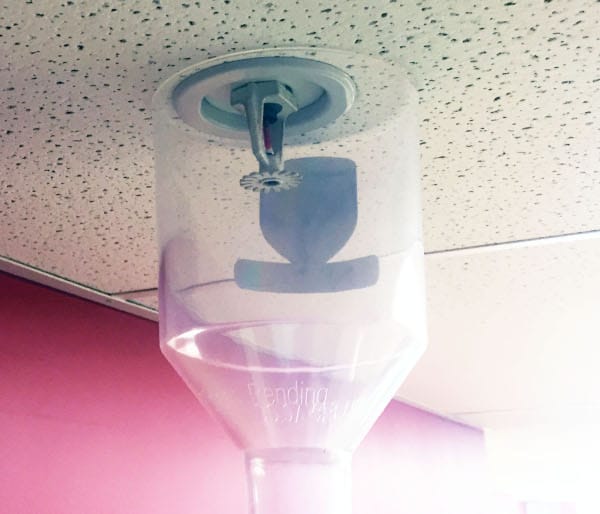Dirty sprinklers must be replaced or cleaned — but you can’t touch them to do the latter. SprinklerVac is the solution for clean fire sprinklers
Update: The SprinklerVac has been discontinued. Read this guide to the current methods of cleaning fire sprinklers, including using compressed air.
Cleaning, like taxes and death, is unavoidable. But even if you’re a pro at removing dust, dirt, and grime, cleaning fire sprinkler heads is uniquely tricky. It’s critical that you correctly follow the guidelines below because one small mistake could result in a very, very bad (wet) day. Accidentally breaking the heat-sensitive element will discharge a sprinkler.
Regular fire sprinkler inspections — and cleaning or replacement, as needed — are necessary to ensure quick sprinkler deployment. Dirty sprinkler heads can cause water spray patterns to become distorted as grime builds up, and the thermal element — most commonly a glass bulb designed to break at a specific temperature — can become insulated from heat, delaying sprinkler activation. There are, of course, also health concerns associated with dust and dirt covering your fire sprinklers. Filthy sprinkler heads in hospitals, restaurants, offices, and hotels can collect and ultimately re-transmit bacteria and viruses.
Unfortunately, it’s all too common to look up and find sprinkler heads coated with dust, grime, and cobwebs. Whether it’s because they are unaware of the problem or uncertain about how to clean them, many building owners, facilities maintenance professionals, and janitorial service providers fall short of accepted standards. But sprinklers must be kept clean — and there is now an easy way to do it without damaging a fragile sprinkler head or violating any fire codes.
NFPA rules for inspecting & replacing heads
The National Fire Protection Association (NFPA) drafts fire protection standards commonly adopted and enforced by local governments through the adoption of model fire and building codes. And NFPA 25: Standard for the Inspection, Testing, and Maintenance of Water-Based Fire Protection Systems outlines the rules for fire sprinkler upkeep. Section 5.2.1.1.1* states:
From the 2023 edition of NFPA 25 [emphasis added on point 5]
5.2.1.1.1* Any sprinkler that shows signs of any of the following shall be replaced:
(1) Leakage
(2) Corrosion detrimental to sprinkler performance
(3) Physical damage
(4) Loss of fluid in the glass bulb heat-responsive element
(5) Loading detrimental to sprinkler performance
(6) Paint, other than that applied by the sprinkler manufacturer, detrimental to sprinkler performance
The operative term in that section is “loading,” which means covered in dirt, dust, grime, or other material. NFPA 25’s first directive is to replace significantly loaded fire sprinkler heads, but there is an option to clean them if the loading is not severe. If you do need to swap one out, check out these 5 tips for replacing fire sprinkler heads.
Replacement is the most expensive way to deal with dirty fire sprinklers; it can render a building or floor unusable while it’s completed and it requires hiring a professional contractor to do the job. Changing sprinkler heads usually involves shutting off the water source, draining the system or a portion of it, removing and replacing the sprinkler head, recharging the system (aka turning the water back on), and then testing the system. This effort takes time, money, and coordination. In short, replacing fire sprinklers is not always the most practical way to keep them clean.
Cleaning dirty fire sprinkler heads
Luckily, NFPA 25 offers two alternatives to replacement. The Annex (A.5.2.1.1.1) states: “In lieu of replacing sprinklers that are loaded with a coating of dust, cleaning sprinklers with compressed air or a vacuum is permitted, provided that the equipment does not touch the sprinkler.”

The first option for cleaning sprinkler heads is to use the same cans of compressed air commonly used to clean keyboards or other electronics. Compressed air is readily available and convenient, but it has some considerations. A liquid propellant that cools any surface it touches drives the air from the can, and this residue could accumulate and accelerate a build-up of substances over time if it’s sprayed too closely. So, avoid spraying the air too near the sprinkler or accidentally poking the head with a nozzle.
The best choice for cleaning fire sprinkler heads
Update: The SprinklerVac has been discontinued. Read this guide to the current methods of cleaning fire sprinklers, including using compressed air.
The best option for cleaning fire sprinkler heads involves vacuuming the dust and cobwebs off the sprinkler. As NFPA states, however, this must be a touchless operation to avoid damaging the sprinkler. And until recently, no fire-protection-specific, touch-free vacuum attachment was available for this specific task. Thankfully, there is now a way to do it:

James Middleton, a retired veteran who has worked in the occupational safety and health profession since 2001, invented the SprinklerVac vacuum attachment to address this need. Seeing the risks to sprinklers posed by canned compressed air and understanding the arduous process of replacing heads, he developed the SprinklerVac to avoid the problems of other options. The SprinklerVac makes cleaning your fire sprinkler heads a whole lot easier.
SprinklerVac’s touch-free operation naturally complies with NFPA standards for cleaning fire sprinklers. The attachment works for nearly every sprinkler head on the market, past or present. Its “trunk-like” end encapsulates the sprinkler head completely, ensuring a safe, efficient cleaning. And it’s see-through to enable easy positioning for touch-free cleaning.
The SprinklerVac’s “one-size-fits-all” design makes it compatible with any standard vacuum. The only thing you need is a typical home vacuum hose (1.25″ connection) or an industrial vacuum hose (1.5″ connection). The SprinklerVac also cleans smoke detectors and recessed and pendant lights.

How to use the SprinklerVac
Cleaning fire sprinkler heads with the SprinklerVac is a simple, 5-step process:
- Securely attach the SprinklerVac to your standard home or industrial vacuum hose.
- Assess the size of the loaded sprinkler head(s) and gauge whether SprinklerVac will clean them touch-free. If it will touch the sprinkler head, adjust the SprinklerVac attachment below the sprinkler head so it does not bump the sprinkler.
- Turn the vacuum on.
- Safely place the SprinklerVac near or over the sprinkler head, looking through the clear plastic to monitor your placement and progress. The SprinklerVac logo, when facing away from the user, is in the shape of a pendent fire sprinkler and was designed to guide your placement.
- Watch the dust, dirt, and cobwebs disappear.
Clean-up is simple, as well. All you need is warm water to rinse the SprinklerVac and a soft cloth to dry it.

It really is the best option to clean fire sprinklers. Avoid spending an immense amount of effort and money replacing dirty sprinklers, or risking a burst bulb using other methods. Grab your SprinklerVac attachment, get the job done, and move on!
It’s a great option to efficiently clean dirty sprinkler heads for building owners or facilities maintenance staff. And janitorial or cleaning professionals can add the SprinklerVac to their current cleaning offerings for a service that differentiates them from competitors and opens up an entirely new revenue stream.
Click here for SprinklerVac, the only touch-free fire sprinkler cleaning vacuum attachment.
This blog was originally posted at blog.qrfs.com. If this article helped you, check us out at Facebook.com/QuickResponseFireSupply or on Twitter @QuickResponseFS.



Hello. Thank you…Excellent article
How do I clean fire sprinklers that are heavily coated with cigarette smoke residue?
Leslie — The simple rule is you can clean them if you can do it without touching them, and since the discontinuation of the SprinklerVac, carefully using a can of compressed air to remove dust or other residue is the best option. If you cannot clean the residue without touching the sprinkler, NFPA states replacing sprinklers is the move. Thanks for reading and commenting.